Today, organizations have plenty of exciting opportunities to reimagine, repurpose, and reinvent their businesses with the cloud. In the last decade, we have witnessed how businesses have adopted the cloud for security, unparalleled scalability, and improved business efficiency.
The answer to which cloud deployment model is ideal for a business among the available options depends on your organization’s computing and business needs. Each cloud deployment model is a piece of a puzzle, and finding the right fit is similar to assembling an empowering solution that brings your business the required scalability, security, and compliance.
In this blog, we’ll walk you through different types of cloud deployment models and how to make the right choice. We will also discuss the benefits and how to achieve success with the right cloud deployment strategy.
What is Cloud Deployment Model?
It refers to an arrangement of distinct environment variables like storage size, ownership, and accessibility of the distribution framework. Cloud deployment models can be categorized based on their location and the entity managing the infrastructure. It works as your virtual computing environment with a choice of deployment model depending on who controls the infrastructure and how much data you want to store. To fully leverage the capabilities of a cloud deployment model, it’s essential to comprehend and pinpoint the type that aligns most effectively with your business requirements and objectives.
Comparative Analysis of Cloud Deployment Models
With the table below, we’ve done a quick comparison of cloud deployment models and what each one has to offer:
| Important Factors to Consider | Public | Private | Community | Hybrid | Multi-Cloud |
| Setup and ease of use | Easy | Requires professional IT Team | Requires professional IT Team | Requires professional IT Team | Complex to setup, integrate, and use |
| Data Security and Privacy | Low | High | Very High | High | Low |
| Scalability and flexibility | High | High | Fixed requirements | High | High |
| Cost Effectiveness | Most affordable | Most expensive | Cost is distributed among members | Cheaper than private but more expensive than public | Higher than the Hybrid model due to different cloud service providers |
| Reliability | Low | High | Relatively Higher | High | High |
| Data Control | Low as the service provider exercises complete control over data | Very high as the user has ownership | High, provided there is collaboration among the members | Very high if the environment is right | Low as the service provider has total control |
| Demand for in-house hardware | No | Yes | No | No need for in-house hardware | No need for in-house hardware |
Things to Consider Before Making The Right Choice
There is no one-size-fits-all approach to choosing a cloud deployment model. That is why you should select a model based on workload by workload. You can start by assessing your business needs and consider what support your application requires.
Before making the decision, ensure you have the answers to the following questions.
- Ease of Use: How tech-savvy and trained are your resources? Does your company have the required time and the resources to upskill them?
- Cost: How much are you willing to spend on a deployment model? How much can you pay upfront for subscriptions, maintenance, updates, and more?
- Scalability: What is your current activity status? Does your system run into high demand often?
- Compliance: Are there any specific laws or regulations in your country that can impact the implementation? What are the industry standards that you must adhere to?
- Privacy: Have you set strict privacy rules for the data you gather?
Different Types of Cloud Computing Deployment Models
Most cloud hubs have tens of thousands of servers and storage devices to enable fast loading. Choosing a geographic area to put the data “closer” to users is often possible. Thus, deployment models for cloud computing are categorized based on their location. To know which model would best fit the requirements of your organization, let us first learn about the different types of cloud deployment models.
Public Cloud
Public deployment models in the cloud are perfect for organizations with growing and fluctuating demands. It also makes an excellent choice for companies with low-security concerns. With this model, you pay a cloud service provider for networking services, compute virtualization, and storage availability on the public Internet. This is also a great delivery model for the teams with development and testing. Its quick and easy configuration & deployment make it an ideal choice for test environments.
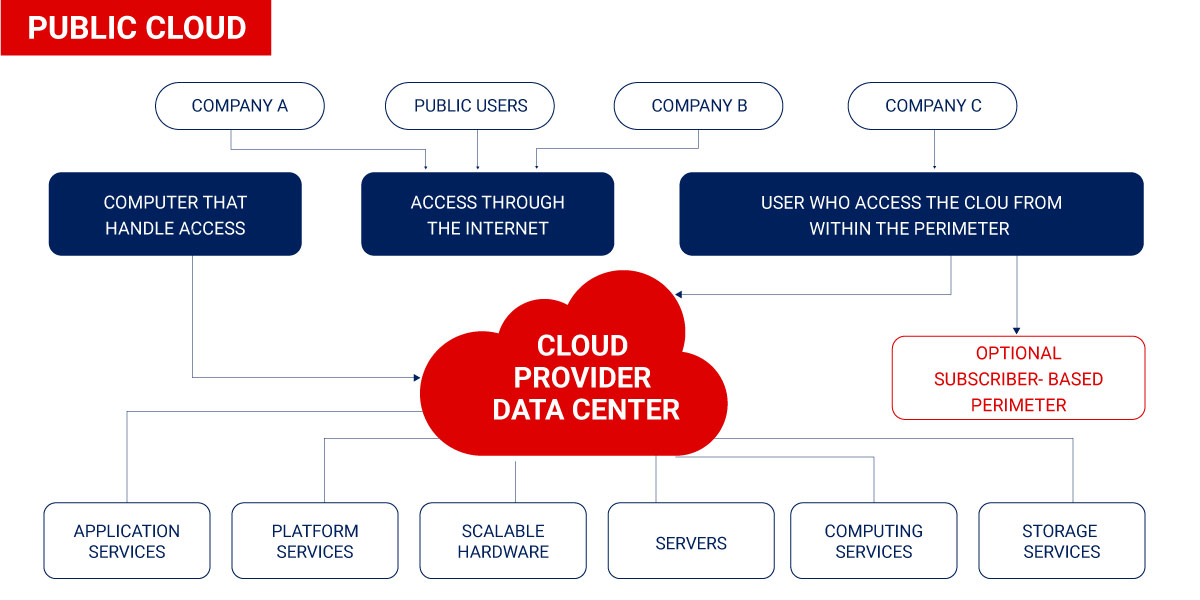
Benefits of Public Cloud Computing
- Significant Cost Savings: Enjoy a pay-as-you-go model, eliminating hefty upfront expenditures. Perfect for businesses seeking rapid resource access.
- Effortless Infrastructure: Utilize the public cloud sans the need for an in-house team for management.
- Boundless Scalability: Data center storage and bandwidth constraints are virtually non-existent and can be scaled as per user demands.
- Cutting-Edge Technology: Stay current with the latest tech trends as public clouds consistently integrate state-of-the-art solutions.
- Command Over Control: Safeguard sensitive assets or low-latency workloads with a private infrastructure under your organization’s control.
- Smooth Transition: Embrace cloud migration gradually, phasing in workloads over time for a hassle-free shift.
Limitations of Public Cloud
- Compromised Data Security and Privacy: Its universal accessibility exposes it to cyber threats and potentially leaves vulnerabilities unchecked.
- Unreliable Performance: Sharing the server network among numerous users heightens the risk of malfunction and outages.
- Usage and License Restraints: A usage ceiling exists despite the multitude of resources available for tenant exchange.
- Control Erosion: Entrusting your technology to the public cloud limits your direct influence. Matters like cybersecurity, configuration, and IT management are relegated to teams distant from your business’s daily operations.
Empowering eCommerce Success: Adoption of Public Cloud for Dynamic Resource Needs
Imagine you are running an eCommerce store and experiencing a surge in traffic and sales around the holiday season. However, you have limited resources available but don’t want to compromise customer service or shopping experience.
In this scenario, you can lease a public cloud to seamlessly handle these fluctuating resource needs. Leveraging the capabilities of a public cloud infrastructure, you can empower your store to;
- Run Operations Efficiently: No need to invest in building the infrastructure. Focus on business operations without worrying about hardware costs.
- Scale Performance on Demand: The public cloud adjusts resources as required, ensuring the website runs smoothly even during peak times.
- Flexible Payment: With a pay-as-you-go model, the financial burden remains manageable, as you are only required to pay for the resources you utilize.
In the near future, if you want to experience a different cloud model, you can smoothly transit without sacrificing responsiveness and compromising the overall performance of your e-store. So, whether it’s about handling holiday season traffic or adapting to changing cloud needs, the public cloud stands as a dynamic solution that will keep your businesses agile, customers happy, and finances in check.
Private Cloud
Businesses that look for cost efficiency and greater control over data & resources will find the private cloud a more suitable choice. Your IT team can either integrate it into your data centre or host it externally. When it comes to customization, the private cloud offers bigger and more suitable business opportunities to fulfill custom business requirements. It’s also a wise choice for mission-critical processes that may have frequently changing requirements.
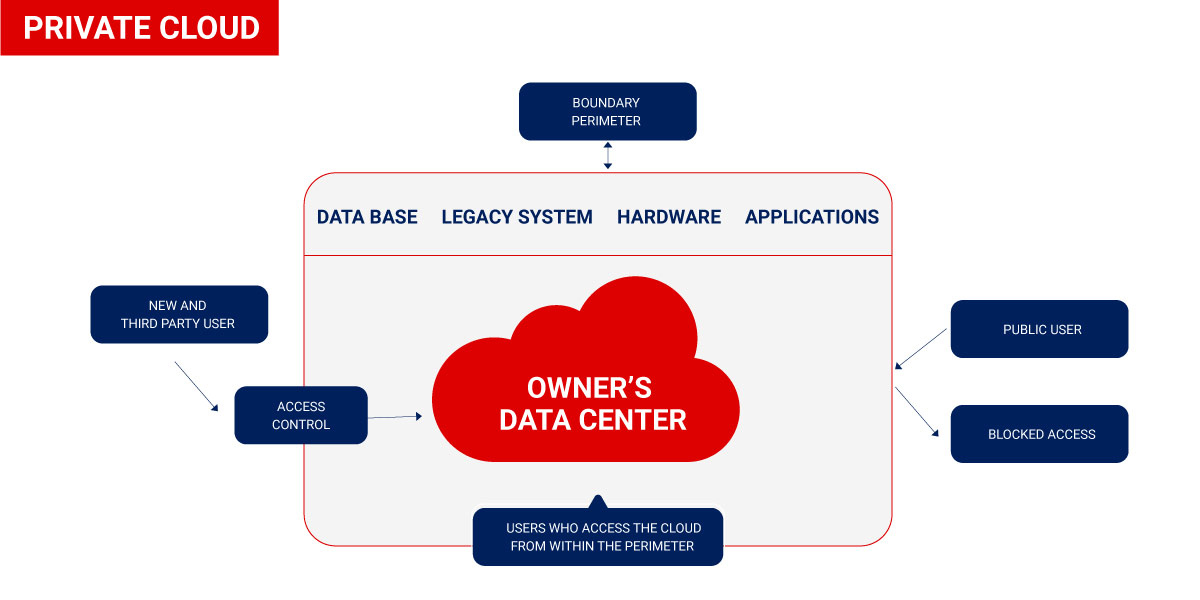
Benefits of Private Cloud
- Data Privacy: It is ideal for storing corporate data where only authorized personnel get access.
- Security: Segmentation of resources within the same infrastructure can help with better access and higher levels of security.
- Supports Legacy Systems: This model supports legacy systems that cannot access the public cloud.
- Full Control: Customers of private cloud solutions exercise complete control over both hardware and software decisions.
- Customization: Enjoy the freedom to customize hardware and software to your preferences within private cloud setups.
- Compliance Assurance: Private clouds emerge as a choice for businesses seeking an uncomplicated avenue, or even the sole path, to fulfill their regulatory compliance prerequisites.
- Confidential Data Management: Opting for a private cloud becomes a natural inclination for those managing confidential documents, intellectual property, personally identifiable information (PII), medical records, financial data, or other sensitive information.
Limitations of Private Cloud
- Higher Cost: Along with benefits, the investment will also be heavier than the public cloud. Here, you will be required to pay for software, hardware, and training resources.
- Fixed Scalability: The scalability depends on the selection of your hardware.
- High Maintenance: Since it is managed in-house, the maintenance costs also increase.
- Access Constraints: Private clouds often boast heightened security measures, translating to more restricted access.
Enhancing Government Operations: The Role of Private Cloud in Central Ministries
Imagine a country’s government relying on thousands of computers to support the infrastructure of its ministries. In such an exclusive scenario, the central government should adopt a secure cloud solution to host private cloud applications. The network would access essential applications like payroll processing, personnel management, back-office systems, and accounting tools. Using a private cloud server, the government can keep its sensitive infrastructure under tight control, ensuring security and complete oversight.
Community Cloud
The community cloud operates in a way that is similar to the public cloud. There’s one difference – it allows access to only a specific set of users who share common objectives and use cases. This cloud computing deployment model is typically managed and hosted internally or by a third-party vendor. You can also choose a combination.
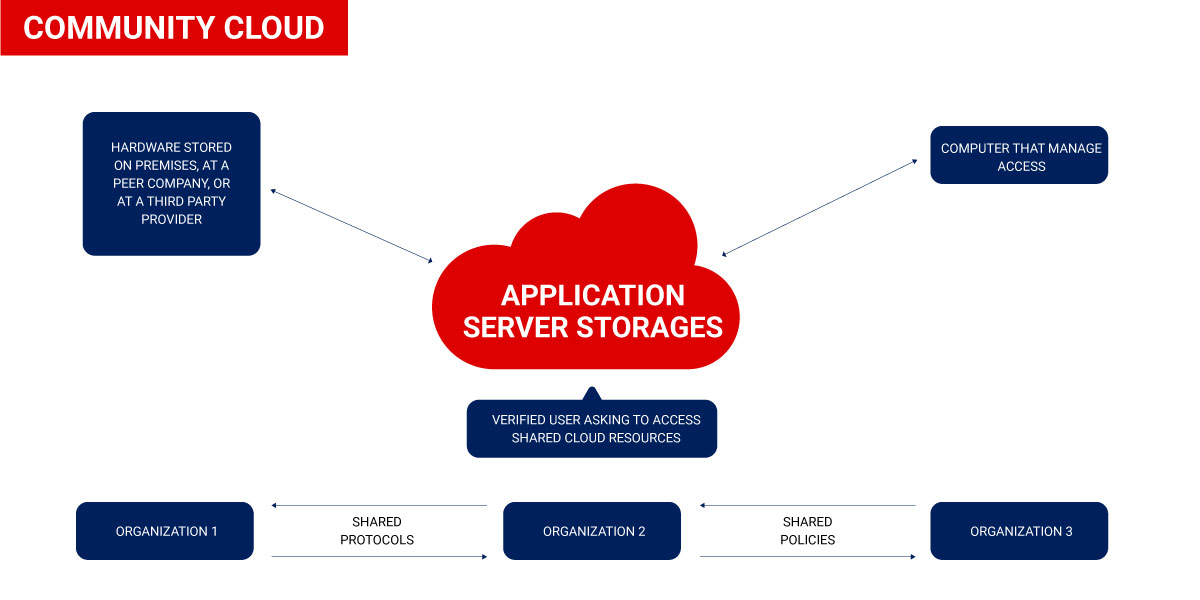
Benefits of Community Cloud
- Smaller Investment: A community cloud is much cheaper than the private & public cloud and provides great performance.
- Setup Benefits: The protocols and configuration of a community cloud must align with industry standards. This allows customers to work much more efficiently.
- Shared Infrastructure: Multiple organizations collaborate within a shared platform, fostering joint projects within a dedicated community, which is particularly useful when a centralized cloud infrastructure is essential for various contributors.
- Security Simplified: By creating a closed user group, organizations can operate within a safeguarded environment, sidestepping the hassles associated with public cloud setups.
- Flexibility: Every user can fine-tune properties to align precisely with their unique needs. It also ensures compatibility while offering the flexibility to adapt to the cloud environment according to individual preferences.
- Reliability & High Availability: The architecture is engineered to provide high availability, ensuring critical services remain accessible and operational, enabling seamless collaboration within the community.
Limitations of Community Cloud
- Shared Resources: Due to restricted bandwidth and storage capacity, community resources often pose challenges that could potentially result in a performance lag.
- Not as Popular: Since this is a newly introduced model, it is not that popular or available across industries.
- Data Uptake Challenges: All members share a fixed pool of data storage and bandwidth, which could cause the setup to slow down the process of adopting and working with data, potentially hampering overall efficiency.
- Cost Consideration: Compared to the public cloud alternative, opting for the community cloud might dig deeper into the pockets.
- The Complexity of Shared Duties: The complex web of tasks and roles can prove challenging to manage, potentially leading to complications.
Streamlining Payroll with Community Cloud for Large Organizations
Imagine a sizable organization grappling with complex payroll processes across two dedicated servers. Years of complications have taken their toll, prompting a shift towards simplicity. Until now, this organization’s payroll system spanned a distributed application, creating a dire need for data retrieval from cloud storage to manage employee data. Seeking for smoother and hassle-free operations, they aim to deploy their app across four VMs to run efficiently.
To eliminate operational delays and time-consuming bottlenecks that plagued payroll processing, the organization should choose a community cloud deployment model – a perfect match for your needs.
This resulted in a speedy and cost-efficient solution. This model also sets the stage for accommodating future expansion. No further modifications were required for the existing payroll app. In the long haul, the organization can seamlessly transit based on its chosen cloud storage provider’s services and tech capabilities.
Hybrid Cloud
A hybrid cloud is a type of cloud computing that combines different cloud models. Each model has its own features and benefits, but they work together as one system. A hybrid cloud can help businesses meet their specific needs and goals. Further, internal or external providers can offer resources as part of this cloud computing deployment model.
Let’s understand the hybrid model better. A company with critical data chooses to use a private cloud; however, a public cloud is preferable for less sensitive data. The hybrid cloud is also frequently used for ‘cloud bursting.’ It means an organization runs an application on-premises but can burst into the public cloud due to heavy load.
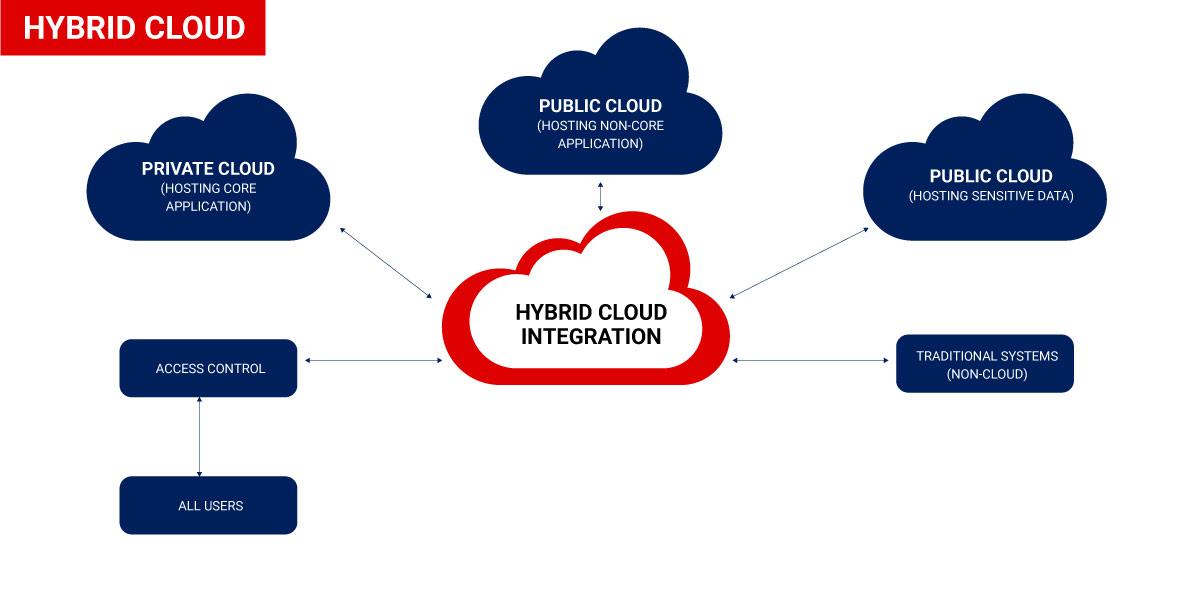
Benefits of Hybrid Cloud
- Cost-Effectiveness: It is a cost-effective approach because it is mainly used by the public cloud to store data.
- Security: Since data is adequately segmented, the chances of data theft from attackers are significantly reduced.
- Flexibility: With higher levels of flexibility, businesses can create custom solutions that fit their exact requirements.
- Control: A hybrid cloud solution allows you to maintain operations within their on-premises network or private cloud.
- Speed: This cloud deployment model enables you to seamlessly move and manage workloads across different cloud environments. This agility allows you to tailor setups to your precise business needs.
Limitations of Hybrid Cloud
- Infrastructure Complexity: Setting up a hybrid cloud is complex since it needs to integrate two or more cloud architectures.
- Specific Use Case: This model makes more sense for organizations with multiple use cases or needing to separate critical and sensitive data.
- Limited Visibility and Control: Your control and visibility over elements owned by public cloud service providers remain constrained.
- Network Bottlenecks: Data transfer between clouds invites potential network bottlenecks.
- Lack of Transparency: Dual platforms could hinder your ability to monitor system performance and track resource usage effectively.
Empowering Central Governments: Harnessing the Potential of Hybrid Cloud Ecosystems
Imagine a central government that needs to create a cloud ecosystem that can serve different states or local administrations. It also needs to keep some sensitive data and internal tasks on local servers. A hybrid cloud solution can help with that. The local administrations can protect their confidential data and save energy and IT staff costs.
Multi-cloud Model
Multi-cloud computing lets you choose the most suitable public cloud service that caters to your unique business requirements. Azure and AWS are two market-leading cloud service providers offering value-added services, tools, and functionalities that cater to different business needs and goals across domains. For example, you can use AWS for your storage needs and leverage the potential of Azure for analytics. This way, you can ensure optimal use of available resources and drive better results. Multi-cloud computing also makes your services more reliable and available with backup options in case something goes wrong.
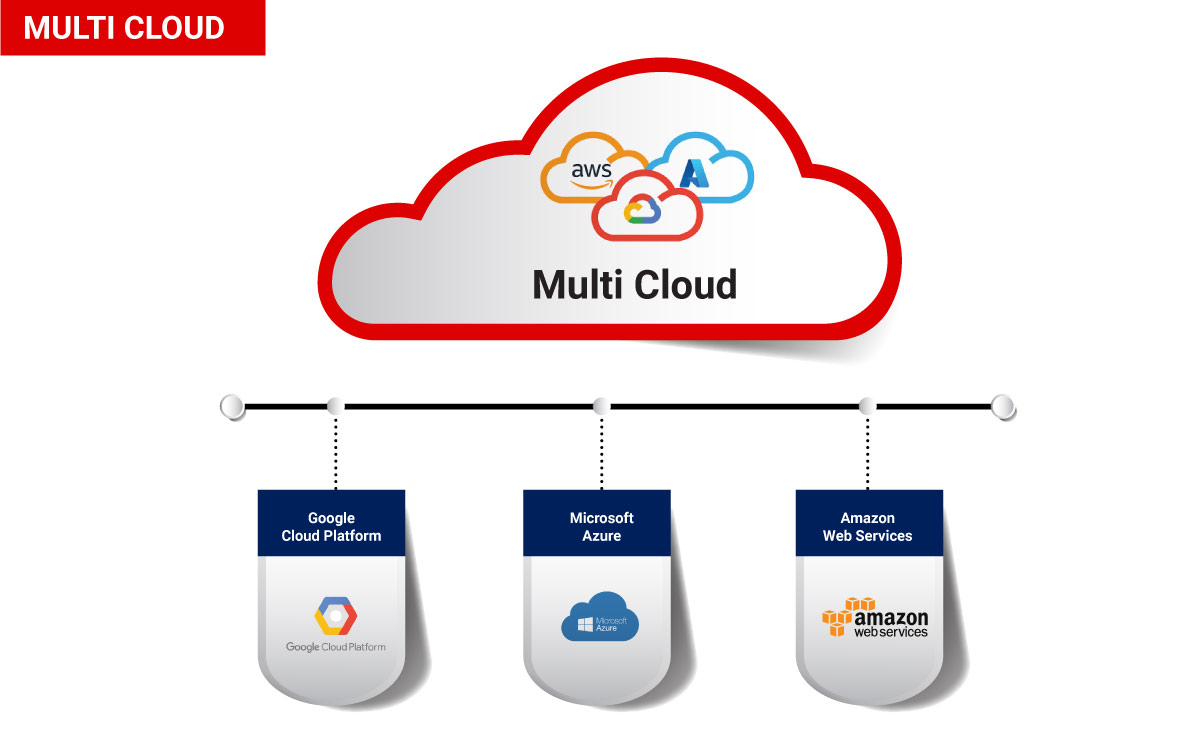
Benefits of Multi-Cloud
- Cost Optimization: By choosing the best cloud service for each workload, multi-cloud can help reduce expenses and avoid vendor lock-in.
- Performance Improvement – Multi-cloud can enable faster data transfer and lower latency by leveraging different cloud providers’ geographic proximity and network capabilities.
- Reliability and availability – It can increase applications’ resilience and fault tolerance by distributing them across multiple cloud platforms and regions.
- Security and Compliance – This model makes it easy to meet the regulatory and security requirements of different industries and regions using the appropriate cloud service for each data type and location.
Limitations of Multi-cloud
- Complexity: It can introduce more challenges in terms of integration, orchestration, monitoring, and governance of multiple cloud services and resources.
- Require Specialized Skills: Multi-cloud can require knowledge and expertise to manage and optimize the performance, security, and cost of different cloud platforms and services.
- Compatibility and Interoperability Issues: It can face issues with data portability, application compatibility, and service integration across different cloud environments and providers.
Boosting Healthcare Excellence with the Multi-Cloud Advantage
Envision a world where healthcare providers are delivering high-quality services across multiple locations. This is possible with a strategy that improves reliability and ensures consistent operations, even in times of crisis. That’s the benefit of a multi-cloud approach customized for the healthcare domain.
With a multi-cloud strategy, healthcare solutions providers can access a high-reliability environment. It’s unlikely that all public cloud systems will fail simultaneously, guaranteeing continuous service provision.
- A Multi-cloud Strategy is not just about increasing bandwidth or improving network performance. It’s about strategically placing deployments near clients and using data from various sources while maintaining fast and smooth data access. Building the entire cloud infrastructure on two solid public cloud systems enables an ‘always-on’ architecture.
- Flexibility of Portability: The multi-cloud path allows for increased portability. Healthcare organizations gain the ability to deploy workloads and data across different cloud environments.
Top 3 Cloud Computing Service Models
Cloud computing makes it possible to render several services, which can be defined according to the roles, service providers, and user companies. The three key cloud service models are broadly classified as below:
IAAS: Changing Its Hardware Infrastructure on Demand
The Infrastructure As A Service (IAAS) means the hiring & utilization of the physical infrastructure of IT (network, storage, and servers) from a third-party provider. The IT resources are hosted on external servers, and users can access them via the Internet.
The Benefits IaaS
- Time and Cost Savings: No installation and maintenance of IT hardware in-house,
- Better Flexibility: On-demand hardware resources that can be tailored to your needs,
- Remote access and resource management.
For Whom?
This cloud computing service model is ideal for enterprises building and managing their own IT platforms. However, they want the flexibility to amend their infrastructure according to their needs.
PAAS: Providing a Flexible Environment for Your Software Applications
Platform as a Service (PAAS) allows outsourcing of hardware infrastructure and software environment, including databases, integration layers, runtimes, and more.
The Benefits PaaS
- Focus on Development: Mastering the installation and development of software applications.
- Time Saving and Flexibility: No need to manage the implementation of the platform, instant production.
- Data Security: You control your business data’s distribution, protection, and backup.
For Whom?
It is ideal for organizations needing help maintaining control over their business applications. However, they wish to get rid of constraints to manage the hardware infrastructure and software environment.
SAAS: Releasing the User Experience of Management Constraints
Software as a Service (SaaS) is provided over the Internet and requires no prior installation. These services can be availed from anywhere in the world at a minimal per-month fee.
The Benefits of SaaS
- No Installation or Software Maintenance Cost Involved
- You benefit from automatic updates with the guarantee that all users have the same software version.
- It enables easy and quicker testing of new software solutions.
For Whom?
SAAS model accounts for 60% of sales of cloud solutions. Hence, it is applicable and preferred by most companies.
How Rishabh Software Can Help You Choose Right Cloud Deployment Model
Rishabh Software is a leading cloud engineering and solutions provider company offering end-to-end cloud services to streamline everyday business challenges. We have a successful track record as an experienced cloud app development company , which makes us a reliable tech partner to transform businesses with cloud technology. Our skilled and top-of-the-line cloud consultant can help you design a successful strategy by choosing the right cloud deployment models for your business. We have helped all shapes and sizes of companies to innovate and scale in the cloud with complete peace of mind.
Frequently Asked Questions
Q: How Does the Private Cloud Differ from the Public Cloud?
A: Private cloud uses the organization’s own infrastructure and offers more control and security. It is also referred to as a data center. However, the public cloud is a subscription-based service that offers more scalability and cost-efficiency to customers looking to avail similar services. Here’s an insightful read that will help you understand the difference between private and public clouds better.
Q: What is the difference between multi-cloud and hybrid cloud?
A: In multi-cloud vs hybrid cloud, the key difference lies in integrating different types of cloud computing services within the infrastructure. A multi-cloud is the blend of two or more public cloud services from different vendors like AWS, Azure, and Google. Whereas a hybrid cloud combines public cloud resources with a private cloud (the organization’s own on-premises data center). Multi-cloud can offer greater flexibility, cost-effectiveness, and resiliency, and hybrid cloud provides great control and security for sensitive data.
Q: How do cloud service and deployment models differ?
A: Deployment models describe how cloud providers deliver resources to users. Service models address the various needs of different businesses or organizations, such as IaaS, PaaS and SaaS.
Q: What are the Examples of Cloud Deployment Models
- Public Cloud: Companies like Amazon Web Services (AWS), Microsoft Azure, and Google Cloud Platform (GCP) offer their infrastructure to users who can share these resources and pay based on usage.
- Private Cloud: These are dedicated, isolated cloud environments providing enhanced security and control. Examples include VMware Cloud, OpenStack, IBM Cloud Private, Dell Technologies Cloud, and Nutanix.
- Hybrid Cloud: This model combines public and private clouds. Leading providers of the hybrid cloud market include MS Azure, AWS, VMware, IBM, Hewlett Packard Enterprise, Cisco, Oracle Cloud, and Dell Technologies Cloud.
- Community Cloud: In this model, multiple organizations with similar requirements share a cloud infrastructure to meet their specific needs while also addressing common concerns, such as security and compliance.
- Muti-cloud: The practice of using multiple cloud providers simultaneously is supported by prominent cloud services providers such as AWS, Azure, GCP, IBM Cloud, Oracle Cloud, VMware Cloud, Red Hat OpenShift, Cisco CloudCenter, Dell Technologies, and HPE.


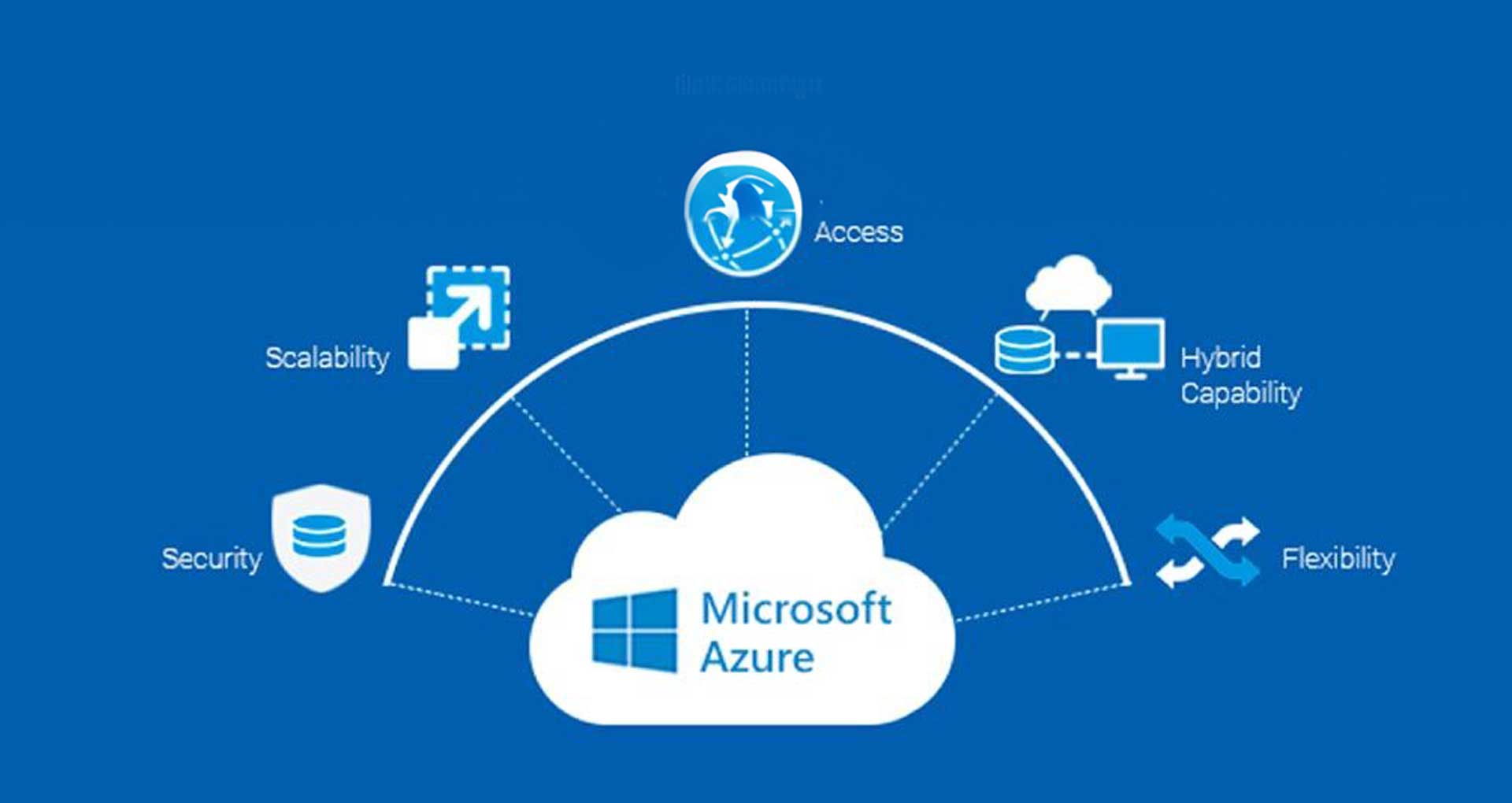








 30 Min
30 Min


